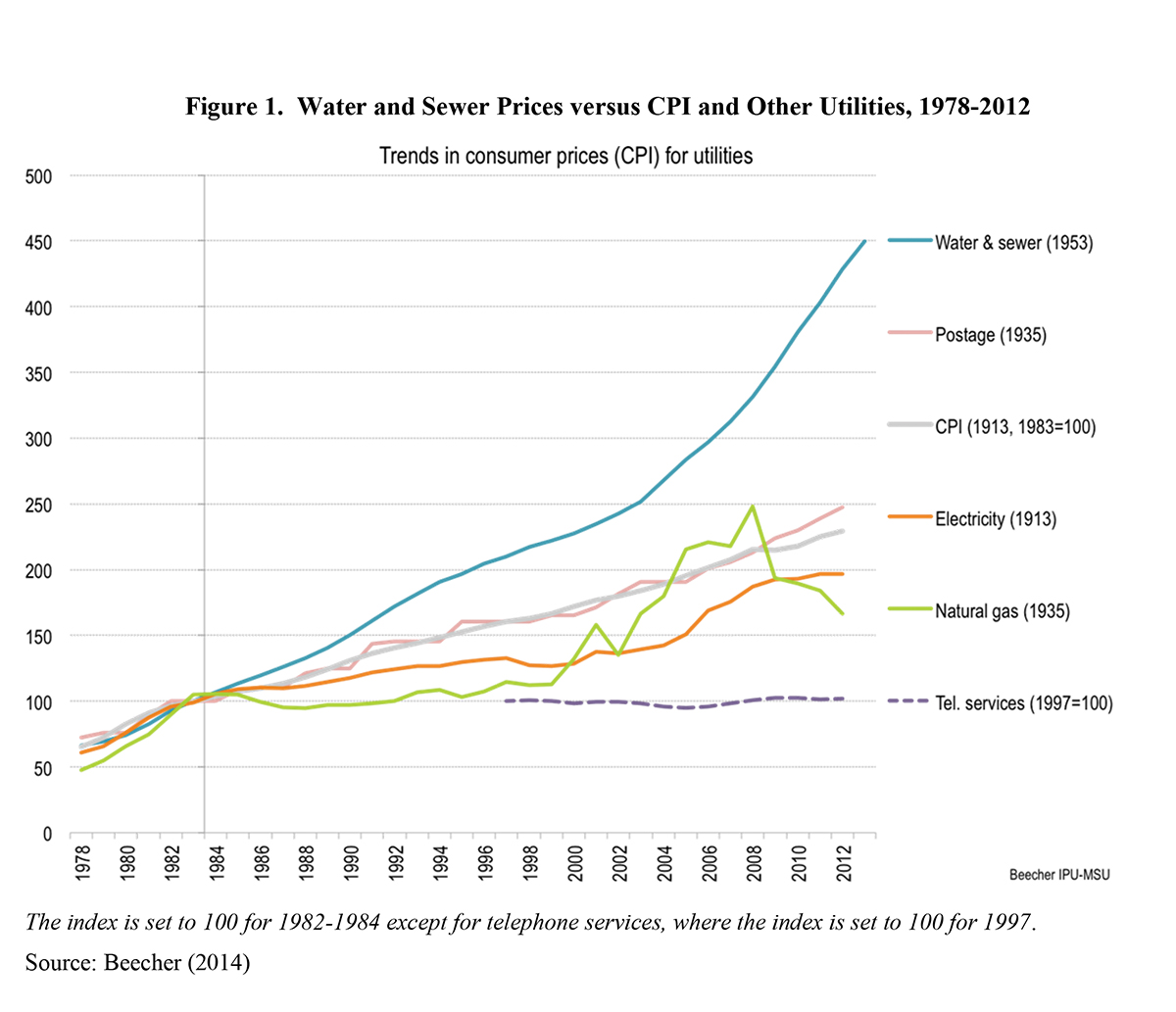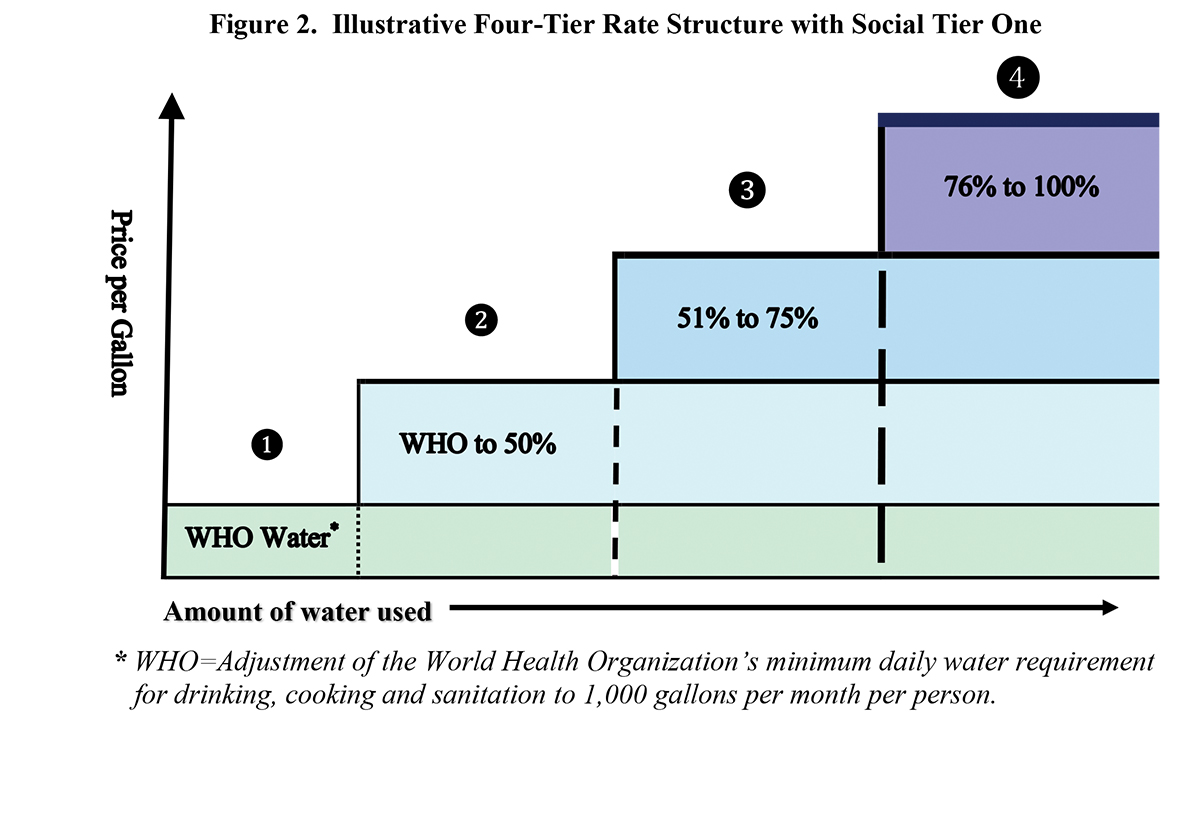Climate and Equity Jobs Act program helps fight the scarcity and inequality that economics creates
Last month, I explored physical shortages of water and nature-based approaches to closing deficits in drinking water. A more common American problem is rapidly accelerating water costs. Water-rate increases since the 1980s far outstripped the consumer price index and all other utilities (Figure 1).
Steep price increases are making water unaffordable for low-income families. For those who can’t pay, water shutoffs result in misery and squalor: no water for drinking, cooking, or sanitation. And the number affected is large. Food & Water Watch estimates that 15 million Americans had water shut off in 2016, a number which is probably larger now.
A two-part program can fix most of this problem and without subsidies or loss of water utility revenue. Part 1 adopts tiered water rates where the price per gallon increases as water use climbs (Figure 2). Under Part 2, water utilities adapt the Climate and Equity Jobs Act’s (SB2408) energy efficiency program, called PAYS® (Pay as You Save) to achieve residential water efficiency.
A majority of water utilities in our drought-plagued West have tiered rates. Water-stressed Las Vegas now charges families $1.46 per 1,000 gallons for 5,000 gallons per month; $2.61 for the next 5,000 gallons; $3.88 for the next 10,000 gallons, and $5.76 per 1,000 gallons for over 20,000 gallons per month. By lowering Tier 1 prices, a water-conservation strategy also becomes water as human right strategy. We can define the first tier as 1,000 gallons per person per month of water pegged at a very low-cost. In a nod to American living standards, this number increases the World Health Organization’s minimum daily water requirement of roughly 750 gallons per month per person. And there’s no subsidy because everyone receives 1,000 gallons of human rights water. Reduced revenue from Tier 1 is recouped from high water charges for tier four.
Tiered rates incorporate this economic principle: claims on scarce resources warrant higher prices. This justifies higher-cost airline tickets for busy travel times and higher electricity charges during peak demand. All in all, tiered rates: (1) achieve social equity by increasing access to affordable water; (2) generate the same revenue so that this system pays for itself; and (3) cut aggregate water flows thereby reducing wear and tear on water infrastructure which will lower long-term capital outlays.
Tiered rates are insufficient because many low-income families have water-guzzling toilets, gushing showerheads, etc. That’s where PAYS® comes in. PAYS® was developed for electricity co-ops to help cash-strapped families cut utility bills through improved home energy efficiency. Insulation upgrades, etc., are paid wholly from savings on utility bills: no up-front costs. Unlike traditional utility efficiency programs, there are no credit checks and no personal loans. Since improvements remain with the home, a tariff is assigned to and remains with the home’s meter should a family move. By keeping water use within or close to the 1,000-gallon allotment, PAYS® will help realize water as a human right.
So, here’s the crux of the issue. Will Illinois cities continue with water rates that are convenient for wealthy, high-volume water consumers, or will they adopt an economically rational scheme to minimize deprivation and suffering through provision of affordable water? Will Social Darwinism or social justice prevail?
References
Beecher, Janice A. 2014. Trends in Consumer Prices (CPI) For Utilities through 2013. Institute for Public Utilities: Michigan State University; https://ipu.msu.edu/wp-content/uploads/research/pdfs/IPU%20Consumer%20Price%20Index%20for%20Utilities%202013%20(2014).pdf
Cillo, Paul A. 2011 (Mar 2). Pay As You Save® (PAYS®): Tariffed On-Utility Bill Efficiency System. Energy Efficiency Institute; http://eeivt.com/wordpress/wp-content/uploads/2013/01/KeystonePresentation.pdf
Clean Energy Works. 2017. Pay as You Save; https://youtu.be/JxoApQkEhyA
Food & Water Watch. 2018. America’s Secret Water Crisis; https://foodandwaterwatch.org/wp-content/uploads/2021/03/rpt_1810_watershutoffs-web2.pdf
Hummel, Holmes. 2017. Pay as You Save; https://www.youtube.com/watch?v=AkI1pJLgT-g
Las Vegas Valley Water District. 2023. Single-family residential water rates; https://www.lvvwd.com/




1 comment for “Heat Waves — In Red & Black: PAYS to provide water like it’s a human right”